Analysis of Business Models, Archetypes, and Value Chains
VerifiedAdded on 2020/02/24
|7
|1810
|140
Essay
AI Summary
This essay delves into the concept of business models, differentiating them from business plans and structures. It explores various definitions and perspectives from scholars, emphasizing the evolution of business models since the 1990s. The essay highlights key works by Zott, Amit, and Massa, and discusses business archetypes (Trade, Product, Service, Subscription, Brokerage, Marketplace, and Ecosystem), activity systems, and revenue architecture. Real-world examples, such as eBay and Magento, are used to illustrate these concepts. The essay analyzes how changes in value chains, such as those experienced by Magento, impact business models. The conclusion emphasizes the importance of different models for different businesses, providing a comprehensive overview of business model theory and its practical application.
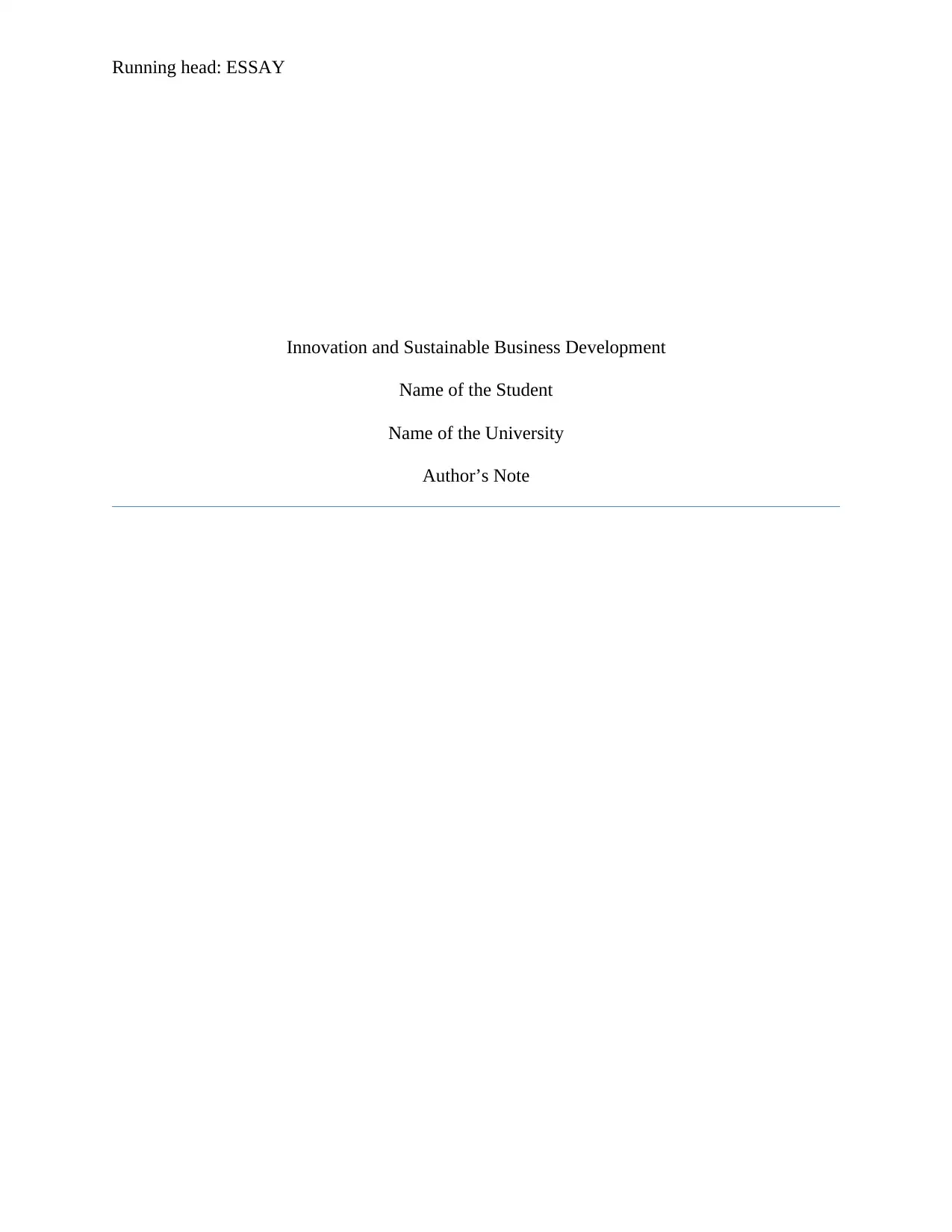
Running head: ESSAY
Innovation and Sustainable Business Development
Name of the Student
Name of the University
Author’s Note
Innovation and Sustainable Business Development
Name of the Student
Name of the University
Author’s Note
Paraphrase This Document
Need a fresh take? Get an instant paraphrase of this document with our AI Paraphraser
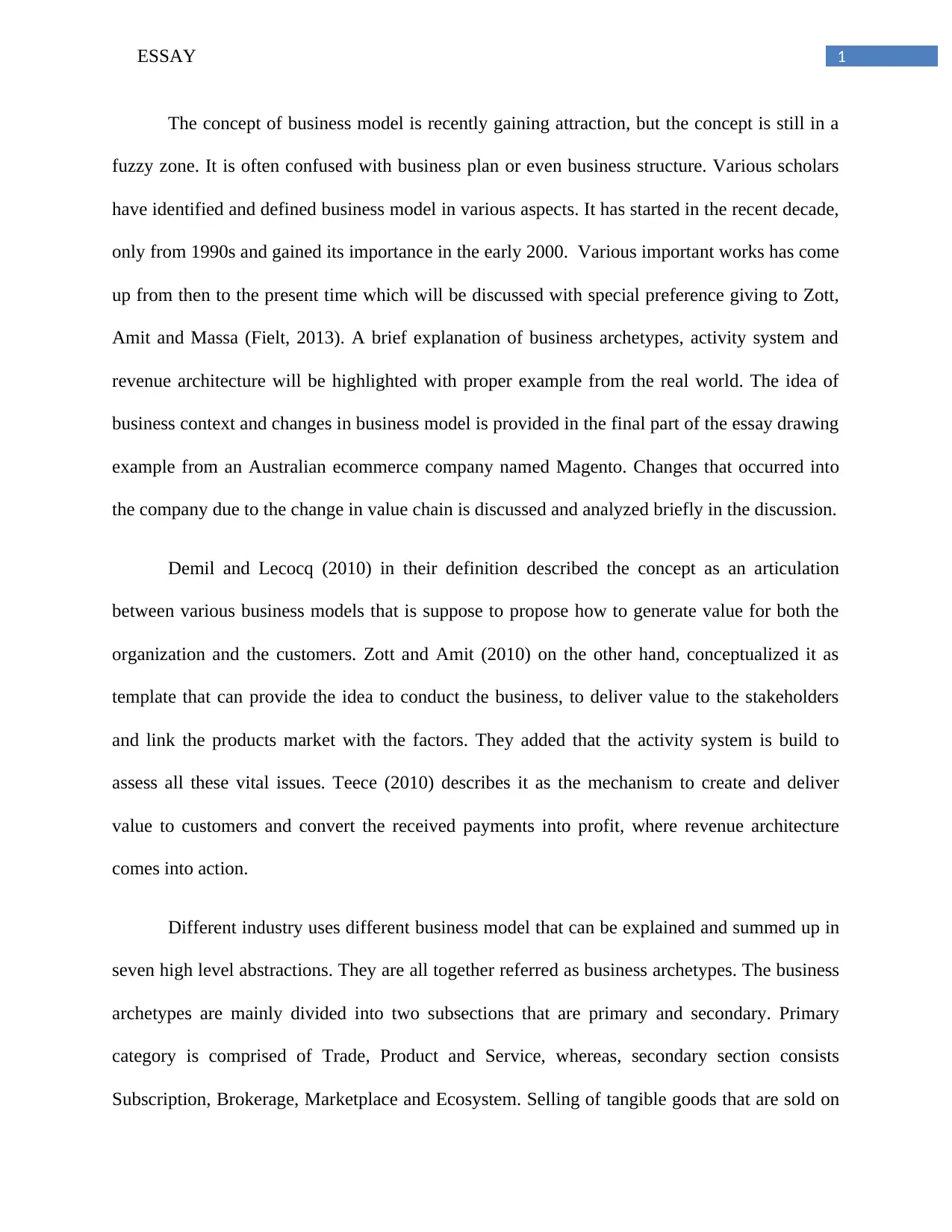
1ESSAY
The concept of business model is recently gaining attraction, but the concept is still in a
fuzzy zone. It is often confused with business plan or even business structure. Various scholars
have identified and defined business model in various aspects. It has started in the recent decade,
only from 1990s and gained its importance in the early 2000. Various important works has come
up from then to the present time which will be discussed with special preference giving to Zott,
Amit and Massa (Fielt, 2013). A brief explanation of business archetypes, activity system and
revenue architecture will be highlighted with proper example from the real world. The idea of
business context and changes in business model is provided in the final part of the essay drawing
example from an Australian ecommerce company named Magento. Changes that occurred into
the company due to the change in value chain is discussed and analyzed briefly in the discussion.
Demil and Lecocq (2010) in their definition described the concept as an articulation
between various business models that is suppose to propose how to generate value for both the
organization and the customers. Zott and Amit (2010) on the other hand, conceptualized it as
template that can provide the idea to conduct the business, to deliver value to the stakeholders
and link the products market with the factors. They added that the activity system is build to
assess all these vital issues. Teece (2010) describes it as the mechanism to create and deliver
value to customers and convert the received payments into profit, where revenue architecture
comes into action.
Different industry uses different business model that can be explained and summed up in
seven high level abstractions. They are all together referred as business archetypes. The business
archetypes are mainly divided into two subsections that are primary and secondary. Primary
category is comprised of Trade, Product and Service, whereas, secondary section consists
Subscription, Brokerage, Marketplace and Ecosystem. Selling of tangible goods that are sold on
The concept of business model is recently gaining attraction, but the concept is still in a
fuzzy zone. It is often confused with business plan or even business structure. Various scholars
have identified and defined business model in various aspects. It has started in the recent decade,
only from 1990s and gained its importance in the early 2000. Various important works has come
up from then to the present time which will be discussed with special preference giving to Zott,
Amit and Massa (Fielt, 2013). A brief explanation of business archetypes, activity system and
revenue architecture will be highlighted with proper example from the real world. The idea of
business context and changes in business model is provided in the final part of the essay drawing
example from an Australian ecommerce company named Magento. Changes that occurred into
the company due to the change in value chain is discussed and analyzed briefly in the discussion.
Demil and Lecocq (2010) in their definition described the concept as an articulation
between various business models that is suppose to propose how to generate value for both the
organization and the customers. Zott and Amit (2010) on the other hand, conceptualized it as
template that can provide the idea to conduct the business, to deliver value to the stakeholders
and link the products market with the factors. They added that the activity system is build to
assess all these vital issues. Teece (2010) describes it as the mechanism to create and deliver
value to customers and convert the received payments into profit, where revenue architecture
comes into action.
Different industry uses different business model that can be explained and summed up in
seven high level abstractions. They are all together referred as business archetypes. The business
archetypes are mainly divided into two subsections that are primary and secondary. Primary
category is comprised of Trade, Product and Service, whereas, secondary section consists
Subscription, Brokerage, Marketplace and Ecosystem. Selling of tangible goods that are sold on
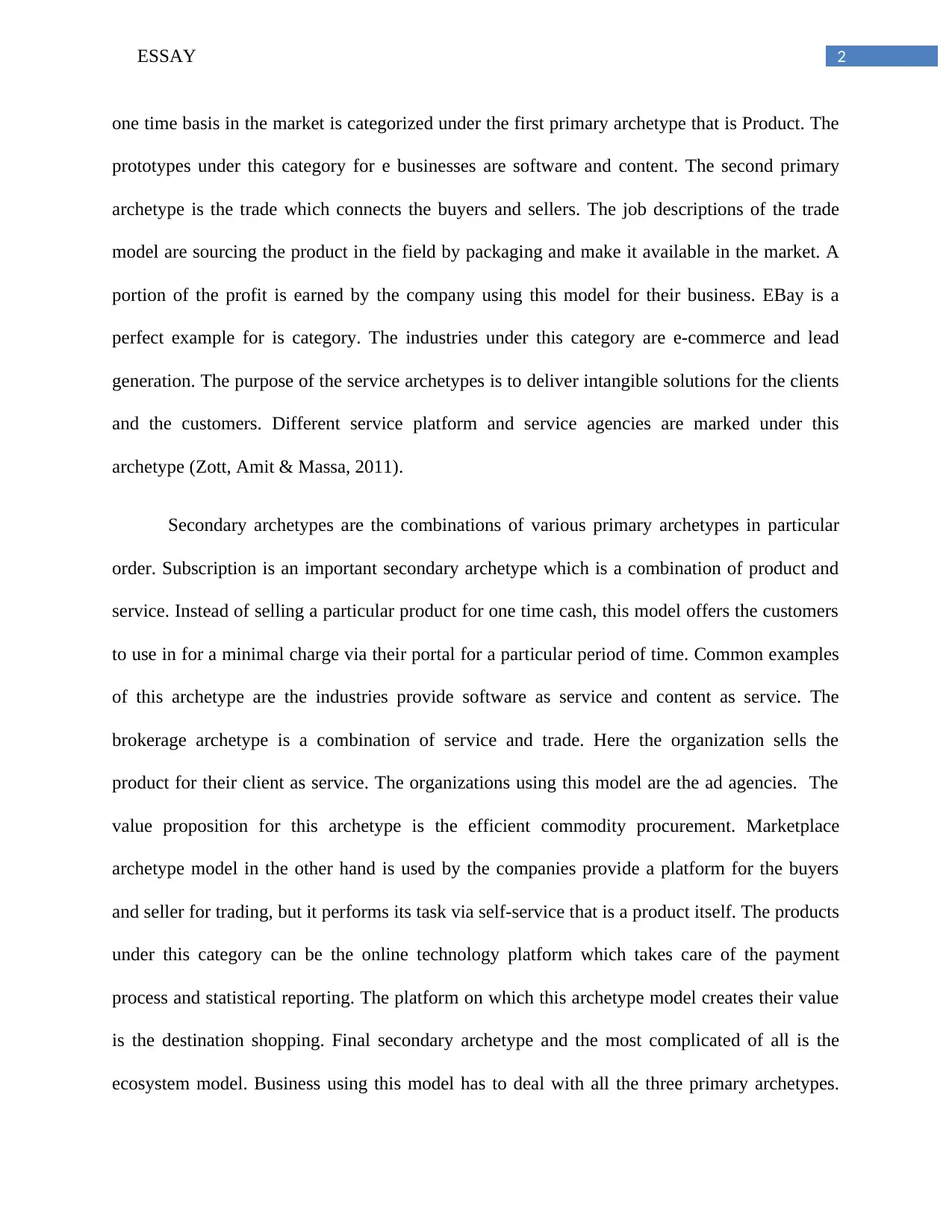
2ESSAY
one time basis in the market is categorized under the first primary archetype that is Product. The
prototypes under this category for e businesses are software and content. The second primary
archetype is the trade which connects the buyers and sellers. The job descriptions of the trade
model are sourcing the product in the field by packaging and make it available in the market. A
portion of the profit is earned by the company using this model for their business. EBay is a
perfect example for is category. The industries under this category are e-commerce and lead
generation. The purpose of the service archetypes is to deliver intangible solutions for the clients
and the customers. Different service platform and service agencies are marked under this
archetype (Zott, Amit & Massa, 2011).
Secondary archetypes are the combinations of various primary archetypes in particular
order. Subscription is an important secondary archetype which is a combination of product and
service. Instead of selling a particular product for one time cash, this model offers the customers
to use in for a minimal charge via their portal for a particular period of time. Common examples
of this archetype are the industries provide software as service and content as service. The
brokerage archetype is a combination of service and trade. Here the organization sells the
product for their client as service. The organizations using this model are the ad agencies. The
value proposition for this archetype is the efficient commodity procurement. Marketplace
archetype model in the other hand is used by the companies provide a platform for the buyers
and seller for trading, but it performs its task via self-service that is a product itself. The products
under this category can be the online technology platform which takes care of the payment
process and statistical reporting. The platform on which this archetype model creates their value
is the destination shopping. Final secondary archetype and the most complicated of all is the
ecosystem model. Business using this model has to deal with all the three primary archetypes.
one time basis in the market is categorized under the first primary archetype that is Product. The
prototypes under this category for e businesses are software and content. The second primary
archetype is the trade which connects the buyers and sellers. The job descriptions of the trade
model are sourcing the product in the field by packaging and make it available in the market. A
portion of the profit is earned by the company using this model for their business. EBay is a
perfect example for is category. The industries under this category are e-commerce and lead
generation. The purpose of the service archetypes is to deliver intangible solutions for the clients
and the customers. Different service platform and service agencies are marked under this
archetype (Zott, Amit & Massa, 2011).
Secondary archetypes are the combinations of various primary archetypes in particular
order. Subscription is an important secondary archetype which is a combination of product and
service. Instead of selling a particular product for one time cash, this model offers the customers
to use in for a minimal charge via their portal for a particular period of time. Common examples
of this archetype are the industries provide software as service and content as service. The
brokerage archetype is a combination of service and trade. Here the organization sells the
product for their client as service. The organizations using this model are the ad agencies. The
value proposition for this archetype is the efficient commodity procurement. Marketplace
archetype model in the other hand is used by the companies provide a platform for the buyers
and seller for trading, but it performs its task via self-service that is a product itself. The products
under this category can be the online technology platform which takes care of the payment
process and statistical reporting. The platform on which this archetype model creates their value
is the destination shopping. Final secondary archetype and the most complicated of all is the
ecosystem model. Business using this model has to deal with all the three primary archetypes.
⊘ This is a preview!⊘
Do you want full access?
Subscribe today to unlock all pages.

Trusted by 1+ million students worldwide
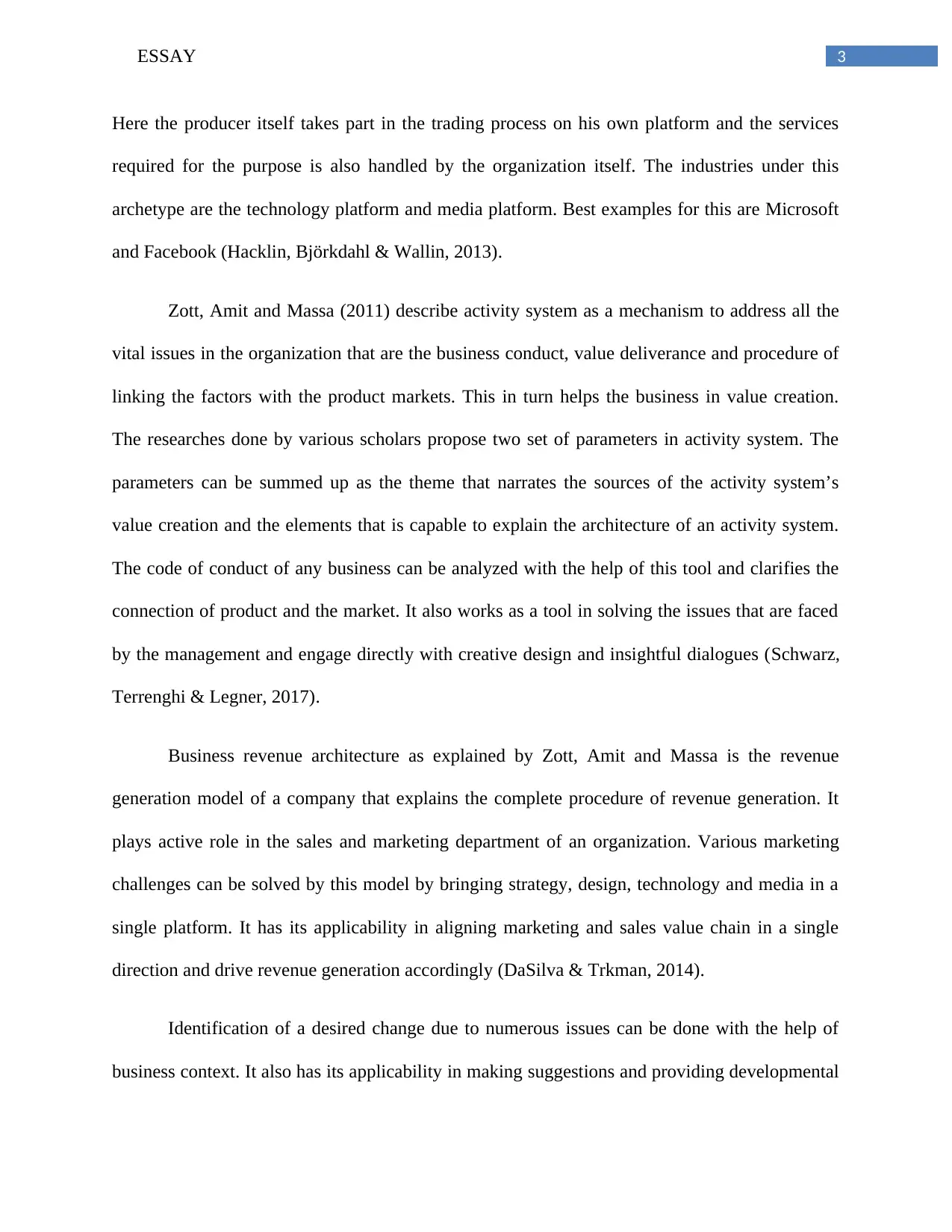
3ESSAY
Here the producer itself takes part in the trading process on his own platform and the services
required for the purpose is also handled by the organization itself. The industries under this
archetype are the technology platform and media platform. Best examples for this are Microsoft
and Facebook (Hacklin, Björkdahl & Wallin, 2013).
Zott, Amit and Massa (2011) describe activity system as a mechanism to address all the
vital issues in the organization that are the business conduct, value deliverance and procedure of
linking the factors with the product markets. This in turn helps the business in value creation.
The researches done by various scholars propose two set of parameters in activity system. The
parameters can be summed up as the theme that narrates the sources of the activity system’s
value creation and the elements that is capable to explain the architecture of an activity system.
The code of conduct of any business can be analyzed with the help of this tool and clarifies the
connection of product and the market. It also works as a tool in solving the issues that are faced
by the management and engage directly with creative design and insightful dialogues (Schwarz,
Terrenghi & Legner, 2017).
Business revenue architecture as explained by Zott, Amit and Massa is the revenue
generation model of a company that explains the complete procedure of revenue generation. It
plays active role in the sales and marketing department of an organization. Various marketing
challenges can be solved by this model by bringing strategy, design, technology and media in a
single platform. It has its applicability in aligning marketing and sales value chain in a single
direction and drive revenue generation accordingly (DaSilva & Trkman, 2014).
Identification of a desired change due to numerous issues can be done with the help of
business context. It also has its applicability in making suggestions and providing developmental
Here the producer itself takes part in the trading process on his own platform and the services
required for the purpose is also handled by the organization itself. The industries under this
archetype are the technology platform and media platform. Best examples for this are Microsoft
and Facebook (Hacklin, Björkdahl & Wallin, 2013).
Zott, Amit and Massa (2011) describe activity system as a mechanism to address all the
vital issues in the organization that are the business conduct, value deliverance and procedure of
linking the factors with the product markets. This in turn helps the business in value creation.
The researches done by various scholars propose two set of parameters in activity system. The
parameters can be summed up as the theme that narrates the sources of the activity system’s
value creation and the elements that is capable to explain the architecture of an activity system.
The code of conduct of any business can be analyzed with the help of this tool and clarifies the
connection of product and the market. It also works as a tool in solving the issues that are faced
by the management and engage directly with creative design and insightful dialogues (Schwarz,
Terrenghi & Legner, 2017).
Business revenue architecture as explained by Zott, Amit and Massa is the revenue
generation model of a company that explains the complete procedure of revenue generation. It
plays active role in the sales and marketing department of an organization. Various marketing
challenges can be solved by this model by bringing strategy, design, technology and media in a
single platform. It has its applicability in aligning marketing and sales value chain in a single
direction and drive revenue generation accordingly (DaSilva & Trkman, 2014).
Identification of a desired change due to numerous issues can be done with the help of
business context. It also has its applicability in making suggestions and providing developmental
Paraphrase This Document
Need a fresh take? Get an instant paraphrase of this document with our AI Paraphraser
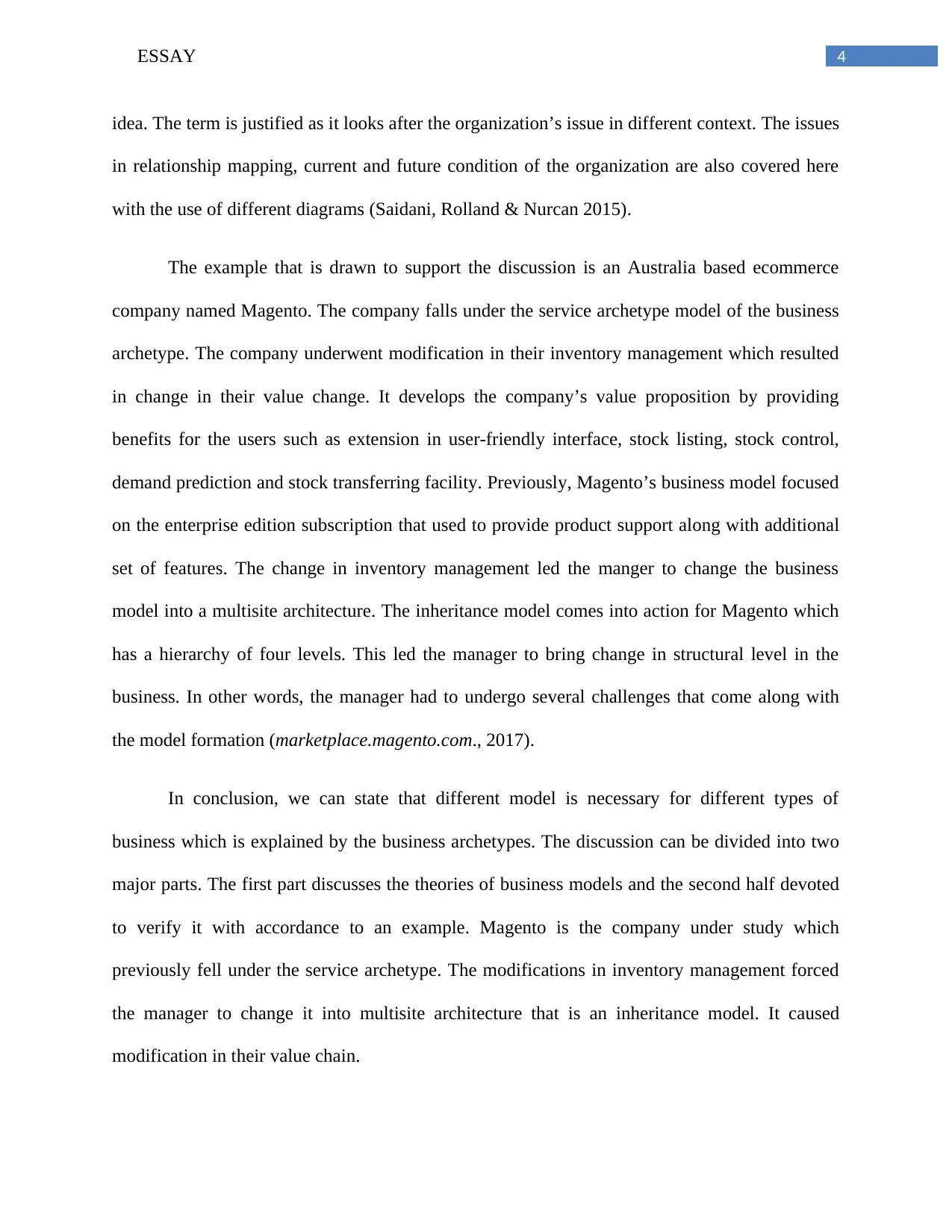
4ESSAY
idea. The term is justified as it looks after the organization’s issue in different context. The issues
in relationship mapping, current and future condition of the organization are also covered here
with the use of different diagrams (Saidani, Rolland & Nurcan 2015).
The example that is drawn to support the discussion is an Australia based ecommerce
company named Magento. The company falls under the service archetype model of the business
archetype. The company underwent modification in their inventory management which resulted
in change in their value change. It develops the company’s value proposition by providing
benefits for the users such as extension in user-friendly interface, stock listing, stock control,
demand prediction and stock transferring facility. Previously, Magento’s business model focused
on the enterprise edition subscription that used to provide product support along with additional
set of features. The change in inventory management led the manger to change the business
model into a multisite architecture. The inheritance model comes into action for Magento which
has a hierarchy of four levels. This led the manager to bring change in structural level in the
business. In other words, the manager had to undergo several challenges that come along with
the model formation (marketplace.magento.com., 2017).
In conclusion, we can state that different model is necessary for different types of
business which is explained by the business archetypes. The discussion can be divided into two
major parts. The first part discusses the theories of business models and the second half devoted
to verify it with accordance to an example. Magento is the company under study which
previously fell under the service archetype. The modifications in inventory management forced
the manager to change it into multisite architecture that is an inheritance model. It caused
modification in their value chain.
idea. The term is justified as it looks after the organization’s issue in different context. The issues
in relationship mapping, current and future condition of the organization are also covered here
with the use of different diagrams (Saidani, Rolland & Nurcan 2015).
The example that is drawn to support the discussion is an Australia based ecommerce
company named Magento. The company falls under the service archetype model of the business
archetype. The company underwent modification in their inventory management which resulted
in change in their value change. It develops the company’s value proposition by providing
benefits for the users such as extension in user-friendly interface, stock listing, stock control,
demand prediction and stock transferring facility. Previously, Magento’s business model focused
on the enterprise edition subscription that used to provide product support along with additional
set of features. The change in inventory management led the manger to change the business
model into a multisite architecture. The inheritance model comes into action for Magento which
has a hierarchy of four levels. This led the manager to bring change in structural level in the
business. In other words, the manager had to undergo several challenges that come along with
the model formation (marketplace.magento.com., 2017).
In conclusion, we can state that different model is necessary for different types of
business which is explained by the business archetypes. The discussion can be divided into two
major parts. The first part discusses the theories of business models and the second half devoted
to verify it with accordance to an example. Magento is the company under study which
previously fell under the service archetype. The modifications in inventory management forced
the manager to change it into multisite architecture that is an inheritance model. It caused
modification in their value chain.
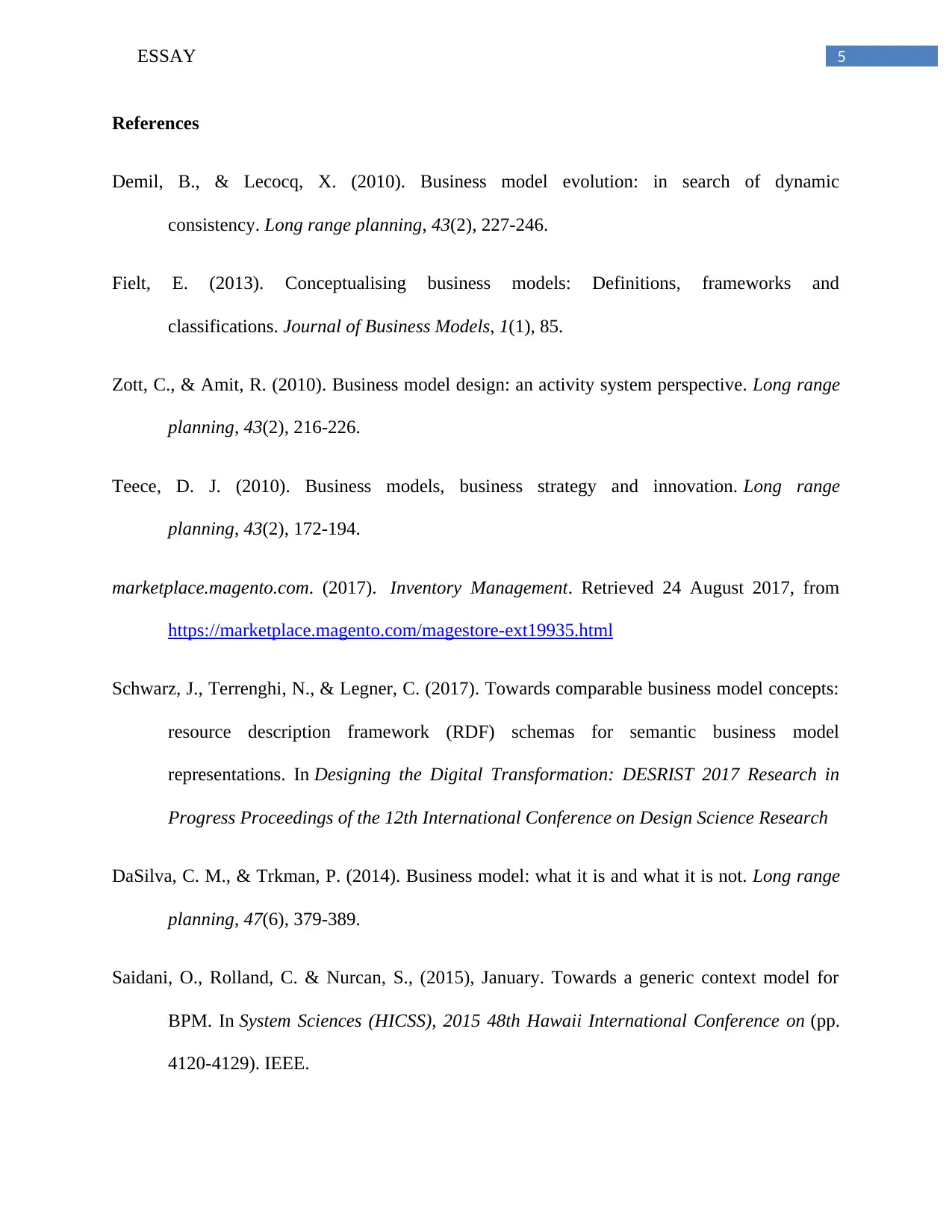
5ESSAY
References
Demil, B., & Lecocq, X. (2010). Business model evolution: in search of dynamic
consistency. Long range planning, 43(2), 227-246.
Fielt, E. (2013). Conceptualising business models: Definitions, frameworks and
classifications. Journal of Business Models, 1(1), 85.
Zott, C., & Amit, R. (2010). Business model design: an activity system perspective. Long range
planning, 43(2), 216-226.
Teece, D. J. (2010). Business models, business strategy and innovation. Long range
planning, 43(2), 172-194.
marketplace.magento.com. (2017). Inventory Management. Retrieved 24 August 2017, from
https://marketplace.magento.com/magestore-ext19935.html
Schwarz, J., Terrenghi, N., & Legner, C. (2017). Towards comparable business model concepts:
resource description framework (RDF) schemas for semantic business model
representations. In Designing the Digital Transformation: DESRIST 2017 Research in
Progress Proceedings of the 12th International Conference on Design Science Research
DaSilva, C. M., & Trkman, P. (2014). Business model: what it is and what it is not. Long range
planning, 47(6), 379-389.
Saidani, O., Rolland, C. & Nurcan, S., (2015), January. Towards a generic context model for
BPM. In System Sciences (HICSS), 2015 48th Hawaii International Conference on (pp.
4120-4129). IEEE.
References
Demil, B., & Lecocq, X. (2010). Business model evolution: in search of dynamic
consistency. Long range planning, 43(2), 227-246.
Fielt, E. (2013). Conceptualising business models: Definitions, frameworks and
classifications. Journal of Business Models, 1(1), 85.
Zott, C., & Amit, R. (2010). Business model design: an activity system perspective. Long range
planning, 43(2), 216-226.
Teece, D. J. (2010). Business models, business strategy and innovation. Long range
planning, 43(2), 172-194.
marketplace.magento.com. (2017). Inventory Management. Retrieved 24 August 2017, from
https://marketplace.magento.com/magestore-ext19935.html
Schwarz, J., Terrenghi, N., & Legner, C. (2017). Towards comparable business model concepts:
resource description framework (RDF) schemas for semantic business model
representations. In Designing the Digital Transformation: DESRIST 2017 Research in
Progress Proceedings of the 12th International Conference on Design Science Research
DaSilva, C. M., & Trkman, P. (2014). Business model: what it is and what it is not. Long range
planning, 47(6), 379-389.
Saidani, O., Rolland, C. & Nurcan, S., (2015), January. Towards a generic context model for
BPM. In System Sciences (HICSS), 2015 48th Hawaii International Conference on (pp.
4120-4129). IEEE.
⊘ This is a preview!⊘
Do you want full access?
Subscribe today to unlock all pages.

Trusted by 1+ million students worldwide
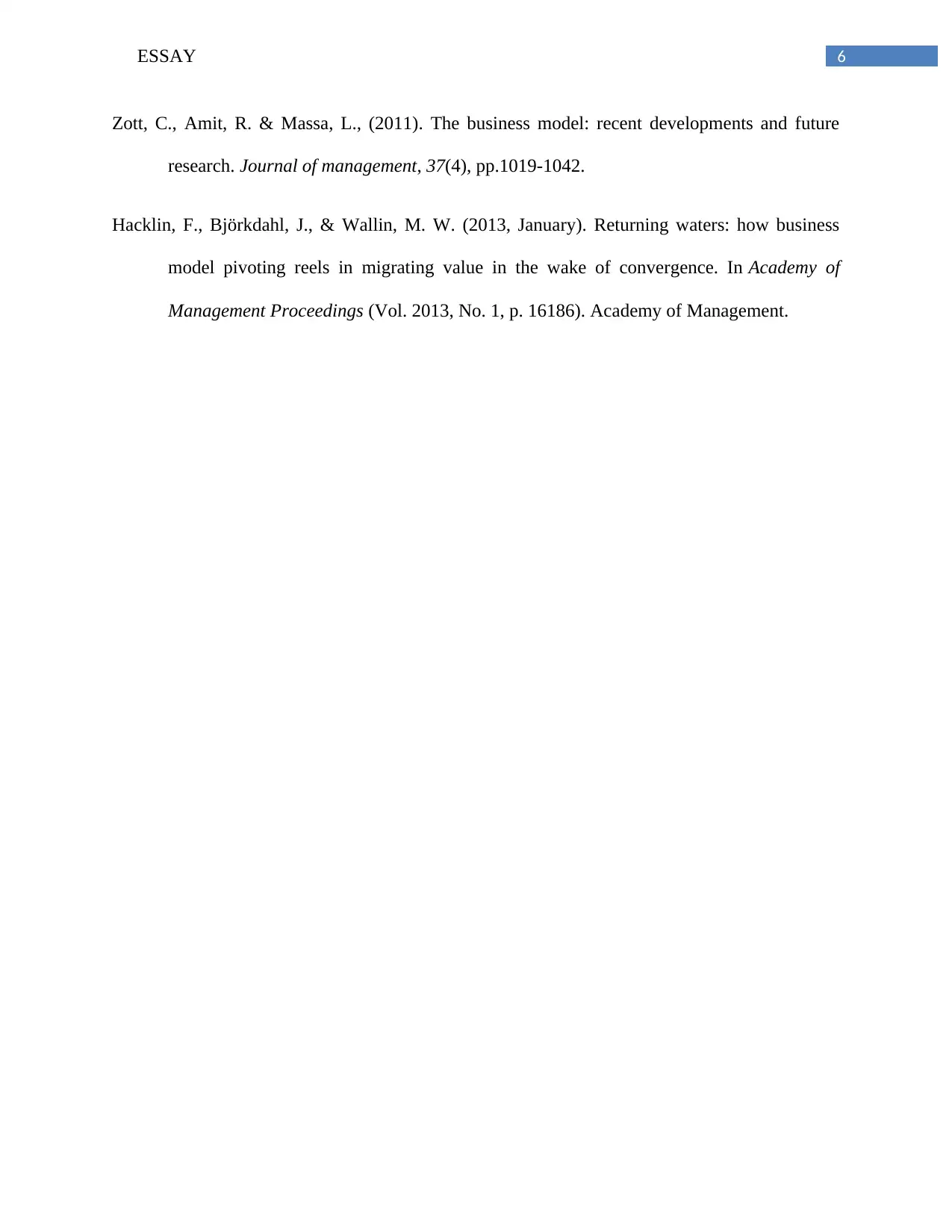
6ESSAY
Zott, C., Amit, R. & Massa, L., (2011). The business model: recent developments and future
research. Journal of management, 37(4), pp.1019-1042.
Hacklin, F., Björkdahl, J., & Wallin, M. W. (2013, January). Returning waters: how business
model pivoting reels in migrating value in the wake of convergence. In Academy of
Management Proceedings (Vol. 2013, No. 1, p. 16186). Academy of Management.
Zott, C., Amit, R. & Massa, L., (2011). The business model: recent developments and future
research. Journal of management, 37(4), pp.1019-1042.
Hacklin, F., Björkdahl, J., & Wallin, M. W. (2013, January). Returning waters: how business
model pivoting reels in migrating value in the wake of convergence. In Academy of
Management Proceedings (Vol. 2013, No. 1, p. 16186). Academy of Management.
1 out of 7
Related Documents
Your All-in-One AI-Powered Toolkit for Academic Success.
+13062052269
info@desklib.com
Available 24*7 on WhatsApp / Email
![[object Object]](/_next/static/media/star-bottom.7253800d.svg)
Unlock your academic potential
Copyright © 2020–2025 A2Z Services. All Rights Reserved. Developed and managed by ZUCOL.





